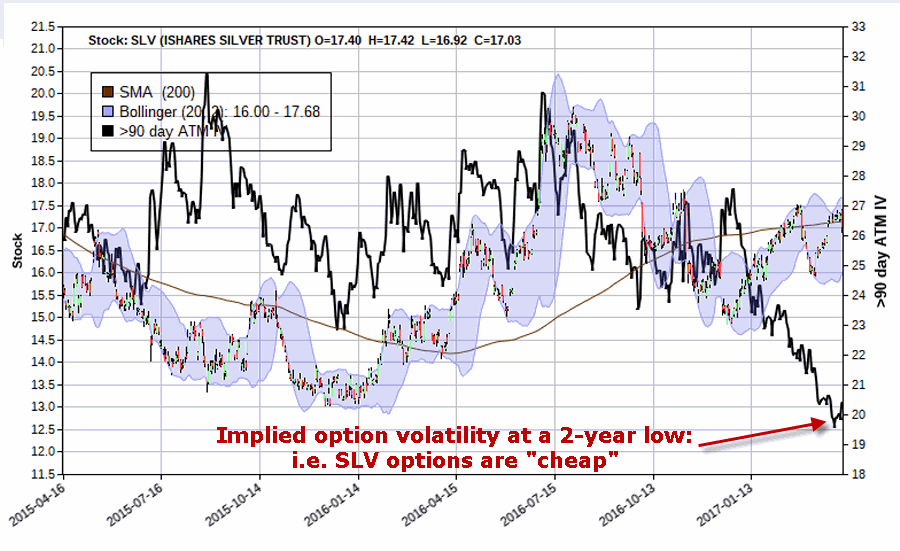The title of this piece sounds like it should be accompanied by the standard “do not try to say this three times fast” warning. In any event, I want to emphasize that what follows is not a “recommendation” but rather an “example” of one unique way to speculate based on a given set of circumstances.
(See also Four Things to Watch for Warning Signs)
Silver
A glance at a chart of ticker SLV (the ETF that tracks the price of silver bullion) will likely lead different traders to reach different conclusions. In Figure 1 we see “the bearish case”, which suggests that silver has strong resistance overhead and that a decline may be in the offing. Figure 1 – A “bearish” chart for SLV (Courtesy ProfitSource by HUBB)
Figure 1 – A “bearish” chart for SLV (Courtesy ProfitSource by HUBB)
Figure 2 displays an “alternative bullish case” for ticker SLV. In the top and bottom clips respectively we see that the Weekly and Daily Elliott Wave counts (generated using an objective algorithm, for better or worse) are both lined up to the bullish side. This would suggest that a breakout to the upside and a larger rally is impending. Figure 2 – A “bullish” chart for SLV (Courtesy ProfitSource by HUBB)
Figure 2 – A “bullish” chart for SLV (Courtesy ProfitSource by HUBB)
So who’s right and who’s wrong? It beats me? One thing I do know (and which you can see in Figure 3 below) is that the implied volatility for options on ticker SLV is extremely low. For the long-winded technical explanations of implied volatility – all the current low reading really means is that the amount of time premium built into the prices for call and put options on SLV is extremely low, i.e., SLV options are “cheap”. Figure 3 – Implied Volatility for SLV options at a 2-year low (Courtesy www.OptionsAnalysis.com)
Figure 3 – Implied Volatility for SLV options at a 2-year low (Courtesy www.OptionsAnalysis.com)
So when we combine:
1) A market that appears poised to make a meaningful price move (but the direction is a question mark)
2) Cheap options
Then 3) we have a good setup for an option strategy known as a “straddle”.
SLV Straddle
A “straddle” simply involved buying a call option and a put option at the same strike price for the same security. In this example we will look at:
*Buying 1 SLV June 17 call option @ $0.61
*Buying 1 SLV June 17 put option @ $0.57
Each 1-lot of this straddle will cost $118 ((0.61 + 0.57) x 100). The particulars appear in Figures 4 and 5 below. Figure 4 – June SLV 17 straddle (Courtesy www.OptionsAnalysis.com)
Figure 4 – June SLV 17 straddle (Courtesy www.OptionsAnalysis.com)
 Figure 5 – June SLV 17 straddle risk curves (Courtesy www.OptionsAnalysis.com)
Figure 5 – June SLV 17 straddle risk curves (Courtesy www.OptionsAnalysis.com)
(See also JayOnTheMarkets.com: Happy ‘Holiday Days’)
Key things to note:
*If this trade is held until June option expiration on 6/16 and SLV closes that day at exactly $17 a share (and wouldn’t that be just my luck?) this trade will lose the entire $118.
*If SLV closes between $15.82 and $18.18 (the breakeven prices) on 6/16 this trade will experience a loss of somewhere between $0 and -$118.
*If SLV is above $18.18 or below $15.82 then the trade will show a profit.
*As you can see by looking at the black line in Figure 4, “time decay” will accelerate in the last 23 days prior to expiration.
*The real hope for this trade is that SLV will make a significant move in either direction sooner than later – i.e., before time decay starts to eat away at the time premium bolt into the option prices – and afford an opportunity to either take a profit (a target might be15% to 20% of the initial cost) or to “adjust” an open profitable trade (see this example) and “let it ride” in hopes of a catching a larger move.
Summary
Is this trade a good idea? I am not actually saying that it is. The only thing I can say is that it is one relatively inexpensive way to speculate on a market that could be poised to make a move. Nothing more, nothing less.
As always, time will tell.
Jay Kaeppel
Disclaimer: The data presented herein were obtained from various third-party sources. While I believe the data to be reliable, no representation is made as to, and no responsibility, warranty or liability is accepted for the accuracy or completeness of such information. The information, opinions and ideas expressed herein are for informational and educational purposes only and do not constitute and should not be construed as investment advice, an advertisement or offering of investment advisory services, or an offer to sell or a solicitation to buy any security.

